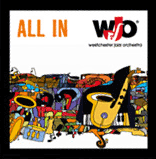A good marriage

Several years ago, feeling somewhat like a “dummy,” I asked Emily Tabin: “What’s a jazz orchestra?” As Executive Director of the Westchester Jazz Orchestra (WJO) she had come to ArtsWestchester offices to sing its praises. She told me that it is an orchestra made up of 17 or 18 instruments, typically saxophones, trumpet, trombone, drums, piano and bass. It sounded to me like the “Big Band” of the 1930s, ‘40s and ‘50s, when bobby-sockers in saddle shoes danced to the music at places like Glen Island Casino. Remember that? Well of course I don’t either, but I heard tell. One distinction of a jazz orchestra is that it usually performs music that is “charted” or highly arranged as opposed to the improvisational kind typical of a jazz combo, which is made up on the spot. WJO has commissioned well over 140 (charted) musical arrangements and recently premiered its first original commissioned work, a three-movement suite inspired by the Hudson River and available online (http://www.westjazzorch.org/all_in.htm).
This month, WJO collaborated on a sold-out event at the Jacob Burns Film Center on a double bill with the documentary, 1959: The Year That Changed Jazz, by filmmaker Paul Bernays. The film tells the story behind four groundbreaking albums released by four jazz masters: Miles Davis (Kind of Blue), Dave Brubeck (Time Out), Charles Mingus (Mingus Ah Um), and Ornette Coleman (The Shape of Jazz to Come). Following the screening, selected tunes from the featured albums were brought to life by a Westchester Jazz Orchestra (WJO) sextet, featuring Jay Brandford (alto saxophone), Scott Wendholt (trumpet), Larry Farrell (trombone), Harvie S (bass), Andy Watson (drums), and Artistic Director Mike Holober (piano).
The neat thing about this particular evening was the collaboration, each partner bringing their product to the stage, in this case both film and live jazz. One of my good friends, Bob Lynch, President of American for the Arts, once complained to me I think in jest that “collaborations are hell.” By that he was acknowledging the monumental effort required by two (or more) organizations, all egos aside, to combine their rare talents to make a new “product” that showcases each, without overpowering the unique offering that each brings to the partnership. Simply put: it’s a marriage. In this context, I admit that I am in favor of marriage. When it works, it can be magic — for organizations, as well as individuals. So let’s encourage marriage and partnerships in these trying financial times. Let’s harness the magic of the Swing era when two could presumably live as cheaply as one, or at least with the modest reductions in overall costs that partnerships foster.
Visit www.artswestchester.org/affiliates/profile/jacob-burns-film-center-media-arts-lab/ for information on the Jacob Burns Film Center and www.artswestchester.org/affiliates/profile/westchester-jazz-orchestra/ to learn more about the Westchester Jazz Orchestra.


Connect with Janet